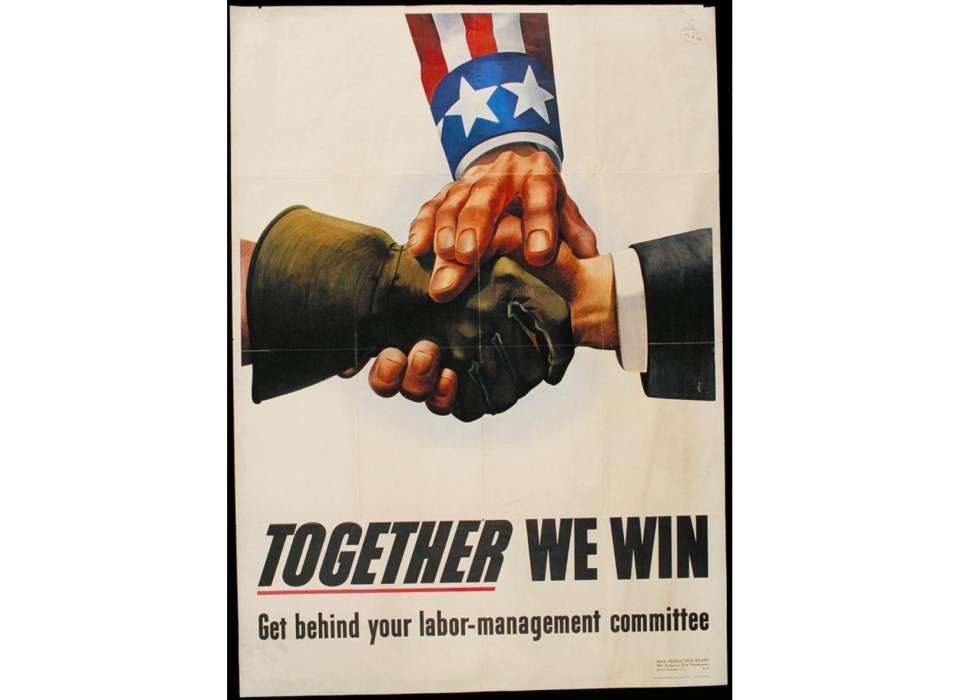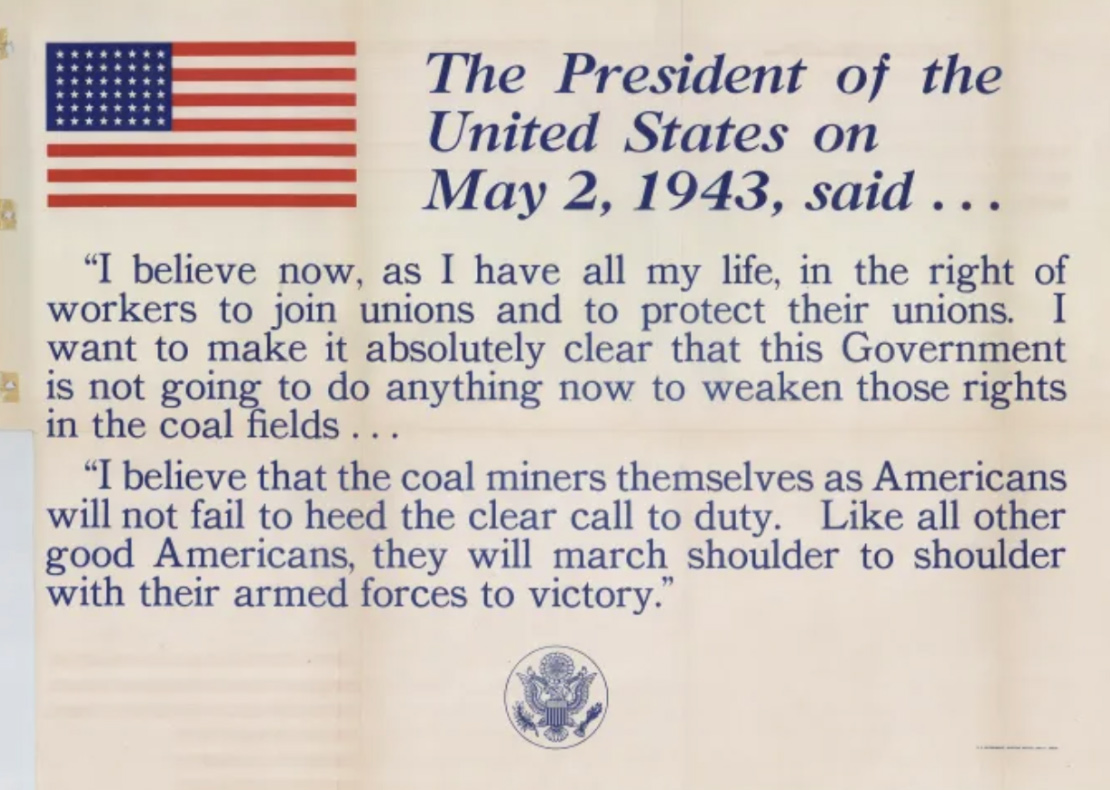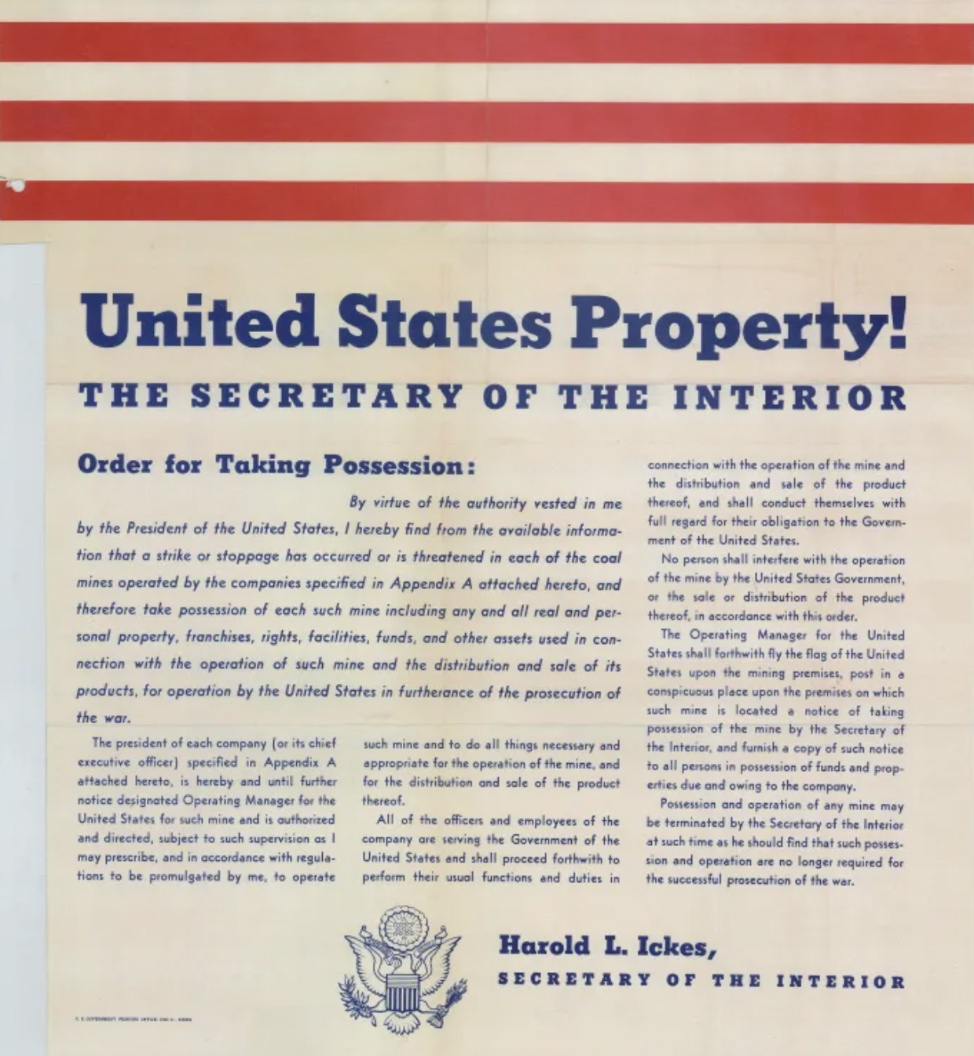Top image: Propaganda poster from the War Production Board, 1943. Courtesy of the National Archives and Records Administration
Though the war was being fought overseas, the presence of the Army National Guard outside the Chicago headquarters of America’s largest retailer, Montgomery Ward & Co., on April 27, 1944, made it seem like a battle was raging on the Home Front.
And, in a way, it was: A long-standing feud between the retail company’s CEO, 70-year-old Sewell L. Avery, and his employees over better pay reached a boiling point when Avery refused to sign a new labor contract and settle the monthlong strike. In response, President Franklin Delano Roosevelt used his executive authority under the Smith–Connally Act to seize operations at Montgomery Ward in the name of securing war supplies.
Newspapers across the country captured photos of soldiers physically removing Avery, a shrewd businessman who made millions supplying the government with everything from farm equipment to machine parts, from his office in Chicago.
“To hell with the government!” Avery yelled as two soldiers hauled him out of his office, arms crossed over his chest and literally dragging his feet so that he needed to be carried.
The scene was entertaining, but Roosevelt’s order for the Secretary of Commerce to operate Montgomery Ward was just one of the president’s dozens of seizures of war-essential enterprises to keep the “arsenal of democracy” in full swing during times of labor unrest.
In June 1943, Congress passed the Smith–Connally Act (or War Labor Disputes Act) to ensure continued wartime production. Sponsoring legislators drafted the bill, which provided presidential authority to seize productions of wartime industries, in response to 1,200 recorded strikes from December 1941 through the late summer of 1942. But employees, union leaders, industrialists, and politicians largely viewed it as a useless law that only increased tensions between labor and employers or as an overuse of presidential power.
Between 1943 and 1945, Roosevelt would use the Smith–Connally Act to intervene in labor disputes and ensure the production of goods to support the war effort—a lasting example of the unique power of the president during World War II and the evolving relationship among the government, workers, and industry.
While Montgomery Ward may have been one of the most newsworthy examples of Roosevelt’s use of the Smith–Connally Act, the legislation had its roots in a coal miners’ strike. After the Japanese attack on Pearl Harbor in December 1941, Roosevelt negotiated a “no-strike pledge” among “Big Labor”—the Congress of Industrial Organizations and the American Federation of Labor—as well as private industrialists to prevent interruptions to manufacturing. But the pledge didn’t spell an end to strikes, which occurred across the country from plane manufacturing plants to vegetable farms in response to increases in costs of living, more demanding hours, and unstable contracts.
When nearly 500,000 miners went on strike to demand better working conditions in April 1943 under United Mines Workers of America leader John Lewis, the Roosevelt administration immediately identified Lewis’s actions as a disruption to crucial war production. In response, the president issued an executive order in May seizing mine operations and allowing for the federal government to operate war industries during times of unrest, followed by signing legislation that made it a federal crime to disrupt seized plants and sites through strikes. The miners—victorious in securing most of their demands—returned to work and operations returned to the mine operators.
Despite the executive order and the legislation criminalizing strikes, two members of Congress—Senator Thomas Terry Connally of Texas and Representative Howard Smith of Virginia—garnered support for a bill that would bear both of their names. Their plan provided sweeping powers to the president to seize the production of any industry deemed crucial in some way for the war effort in response to actual and threatened strikes. Any unions representing employees in wartime industries that failed to give 30 days’ notice of an intent to strike would be financially liable for lost production costs.
But not everyone was convinced of the need for a law that went to such a far extent to protect war production, including Roosevelt, who vetoed the bill once it reached his desk on June 25, 1943. Roosevelt believed the proposed legislation went too far in its prohibitions on unions, including direct negotiations with employers. True, there were those who violated the “no-strike pledge” during the first year of the war, but Roosevelt argued in his veto that this was the minority and that the low instances of strikes was a “record has never before been equaled in this country.” Roosevelt argued that the bill could potentially create more opportunities for strikes rather than limit them by souring employer-employee relations. The government could not risk creating opportunities for conflicts, which “far from discouraging strikes … would stimulate labor unrest and give Government sanction to strike agitations.”
Others across the country had similar concerns, even after Congress overrode Roosevelt’s veto and passed the Smith–Connally Act on June 25, 1943. Len De Caux wrote for the CIO News that while the bill claims to support an anti-strike stance, it actually “encouraged strikes by outlining the conditions under which they could be called.” Pro-labor journalist Russ Richeson argued that the act interfered with the negotiating relationship between employer and employees, while anti-Roosevelt critics railed that the act would give too much power to the president.
Despite his hesitancy to sign the bill, Roosevelt’s administration would go on to rely upon its powers, with the seizure of Montgomery Ward stores and properties in April 1944 being one of the most highly publicized instances. Sewell Avery had a long history of disputes with employees over pay and contracts as well as violating wartime measures, including price ceilings on women’s and children’s clothing. Montgomery Ward employees went on strike nationwide in late 1943 after Avery refused a new negotiated contract with United Retail, Wholesale and Department Store Union, despite orders from the War Labor Board; this prompted Roosevelt to order the Secretary of Commerce to seize Montgomery Ward properties. Photos of a smiling Avery being removed from his office by soldiers made front page news.
Avery—who had successfully secured contracts to supply Allied troops with goods as well as farmers with the tools needed to continue wartime production—claimed the move was illegal because his company was not engaged in wartime production, but rather sold consumer goods. Roosevelt proclaimed in a conference on his move that he would “not tolerate any interference with war production in this critical hour” and emphasized his views that strikes and labor disagreements of any kind would not be condoned during times of war.
Roosevelt’s use of the Smith–Connally Act drew mixed opinions from the public. An article in the Detroit Times blasted the president’s seizure as a “high-handed act” that “closely border[ed] on supra-constitutional dictatorship” and violated property rights. Others wondered just how far the act empowered the president to go in determining what was a war production facility and what was not. Even foreign newspapers picked up on the event and used it for anti-American propaganda purposes. The Berlin radio broadcast called Roosevelt’s actions a “sensational and illegal occupation by United States troops” that detracted troops and energy from the war effort.
According to a poll, 60 percent of Americans disagreed with the seizure, believing it to be an example of Roosevelt’s abuse of wartime and presidential powers. The unpopularity of the use of the act led to an investigation by a House committee, and two weeks later, operations were returned to Montgomery Ward.
But Roosevelt once again invoked Smith–Connally later that year when Avery refused to sign another contract and his employees went on strike. So again, on December 27, 1944, the government seized control of Montgomery Ward facilities across the country. Avery resisted and engaged in a legal battle that resulted in his case reaching the US Court of Appeals for the Seventh Circuit. Judges ruled in favor of the government’s seizure, and Avery was set to appeal to the Supreme Court, but the government returned operations to him in October 1945, after the war.
Although the Smith–Connally Act expired in the fall of 1945, its significance for wartime production and labor relations on the Home Front remained. In 1947, amid a growing anti-communist movement in light of the Cold War with the Soviet Union, Congress passed (over President Harry S. Truman’s veto) the Taft-Hartley Act, which limited the activities of unions and retained some power for the president to intervene against strikes if they endangered national security. Some experts claim that the Smith–Connally Act kept production humming, contributing to an Allied victory and the United States’ ability to outproduce opponents, while others view it as an example of a broad expansion of federal oversight during the war. Opinions vary, but the Smith–Connally Act tells an important—and often overlooked—story of the labor battle at home while battle raged abroad.
Stephanie Hinnershitz, PhD
Stephanie Hinnershitz is a historian of twentieth century US history with a focus on the Home Front and civil-military relations during World War II.
Cite this article:
MLA Citation:
APA Citation:
Chicago Style Citation:








![Max Fuchs, New York City cantor, sings as Rabbi Sydney [sic] Lefkowitz, Richmond, VA, conducts the first Jewish services from Germany.](/sites/default/files/styles/max_650x650/public/2025-10/image1.jpg)


